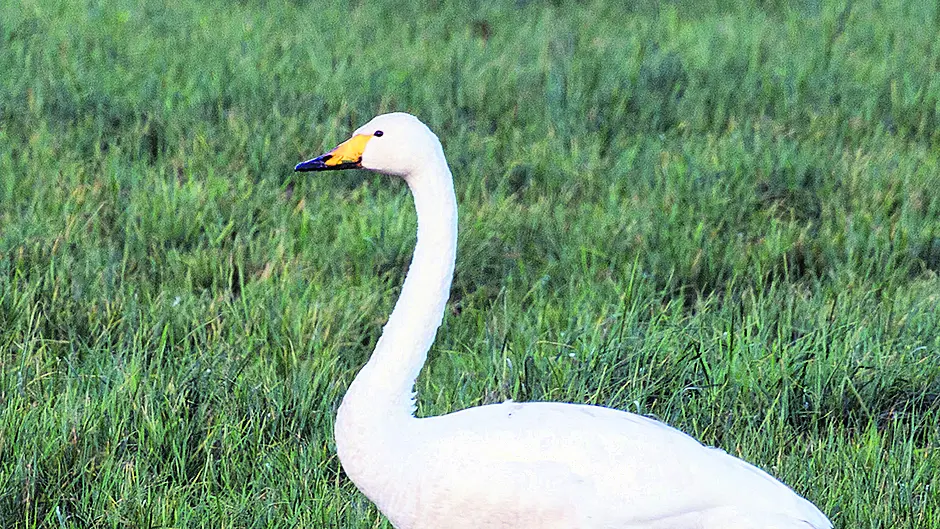A RECENT trip brought me to Farranamanagh (‘land of the monks’) on the Sheeps Head Peninsula, which is truly an extraordinary place. Its curved bay features a spectacular beach scattered with rounded quartz stones and, behind the strand, a fresh water lagoon nestles beneath the surrounding hills.
There was an abundance of water birds of all descriptions there when I visited, both on the shoreline and in the lake, and their calls echoed around the still amphitheatre of the bay.
One distinctive sound, however, caught my attention – the bugling ‘whoop’ sound of the whooper swan – as it’s not often heard in West Cork.
Wild swans
Mute swans, with their classic S-shaped necks, are the resident swans commonly seen here in West Cork.
However, these well-known swans are probably not native to Ireland. They were, most likely, brought here from Britain from around the 12th century as ornamental birds.
So it is the migrant species, the whooper and Bewick’s swans, that are really the ‘wild swans’ that feature in Irish myth and folklore.
Collectively known as winter swans, or wild swans, these migrants are similar in appearance to the more familiar mute swan.
However, they have long straight necks and yellow and black beaks instead of the mutes’ orange-red bills and curved necks. While the winter swans look alike, they are actually two distinct species with the smaller Bewick’s breeding in Arctic Siberia and the whooper in Iceland, Scandinavia and Russia.
Migrants
Whoopers start to arrive here in October and generally stay in Ireland until around March.
Their journey is around 13,000 kilometres and, in ideal conditions, the birds can do it in around 13 hours of flight. But the winter migration can mean turbulent weather so migration can take several difficult days flying.
The whooper migrates in a classic V-shaped formation, with the bird at the point of the V changing regularly to enable it to rest in the slip stream of the other birds.
When the whoopers first arrive in Ireland they congregate in large flocks on Lough Foyle and Lough Swilly. Later on, after feeding up after the long journey, they break up into groups and head further south, with a few making their way to West Cork.
Ireland holds 20% of the world’s winter population of whooper swans and their numbers increased by some 39% between 1991 and 2015.
Myth and legend
Swans feature very strongly in Irish myth and legend and the Children of Lir is probably the best-known fable in Ireland.
After spending 900 years at sea as swans, it is said that these children came ashore to die near Allihies village on the Beara Peninsula. Attracted by the sound of a bell rung by a monk, when they came onto land they immediately reverted to their human form, to die as old men and women there.
Three large white boulders mark their graves and traditionally ‘rounds’ were performed around them, with money left as an offering to the children.
Other locations in Ireland also claim to be the landing place of the Children of Lir, but we here in West Cork know that it really happened at Allihies.
The belief that swans embodied the souls of people was a strong one and so swans were considered very sacred and killing one was completely forbidden.
It was also believed that a swan’s song could put a person under a spell. While bewitched in this way, time would be accelerated and so the person could awaken to find themselves in a totally changed world due to the passage of time.
Another belief associated with the swan is that it would sing a song in the moment before death – the so-called ‘swan song’. This concept dates back at least to the time of Aristotle.
There may be a solid reason for this latter belief as it is said that a whooper swan is shot, it expels air involuntarily and makes a song-like sound.
The resident swans at Farranamanagh on the Sheeps Head are said to be inhabited by the souls of the sons of the King of Spain. Hundreds of years ago, the boys came to the nearby Bardic School to be educated but were tragically drowned in the lake at Farranamanagh. Transformed into swans at death, they still haunt this beautiful place today.
Subscribe to the Southern Star's YouTube channel, like us on Facebook and follow us on Twitter and Instagram for all the latest news and sport from West Cork.






